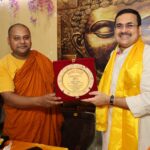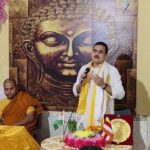Preserving the ‘freedom’ spirit
- By : Anirban Ganguly
- Category : Articles

The ruling dispensation is spearheading efforts to salvage the symbols of freedom struggle which had been neglected by the Congress
Ideally, the 75th anniversary year of India’s independence could have also been an occasion for the Congress party to introspect, commemorate and come up with a series of meaningful programmes, projects and initiatives to celebrate the year.
Even though it is known that this Congress is not the Congress of the freedom movement, that this is a Congress born in 1969 and that the Congress of the freedom movement was conclusively consigned to the pyre that year, nevertheless, as a party which proclaims itself to be a continuum of the Congress of the freedom movement, one would have expected it to pay serious heed to this occasion.
But the present Congress leadership, embroiled as it is, in a cycle of internal dissensions, open rebellions and political and ideological waywardness has not been able to come up with something creative. It has, instead, persisted with its mindless criticism of some of the major initiatives that Prime Minister Modi has launched in the larger civilisational context of this sacred occasion. In doing so, it has in fact, made a greater caricature of its essentially imbecile political-self.
This negativity and opposition, the Congress has often attempted to prop up on the shoulders of a selective group of self-styled Gandhians, leftist intellectuals of many hues from within the wide and complex spectrum, comprising of communists, naxals and Maoists — elements who have hardly ever believed in the legacy of the freedom struggle.
It is this attitude which had led the present Congress leadership to oppose the Jallianwala Bagh National Memorial (Amendment) Bill, when it was passed in 2019. Displaying a monopolistic mindset which reeked of disrespect for the memory of the martyrs of Jallianwala Bagh, it opposed the Modi government’s effort to make the Jallianwala Bagh National Memorial Trust apolitical and truly representative and symbolic of the whole country.
In order to make the trust which was tasked to run the Memorial apolitical, the Modi government pushed for ‘removing the clause pertaining to the President of the INC as a permanent member of the trust.’ The fact that a further amendment made was that of including the ‘Leader of Opposition recognised as such in the House of the People (Lok Sabha) or where there is no such Leader of Opposition, then leader of the single largest opposition party in that House as a member of the trust’ demonstrated its genuine intent. Congress’s opposition stemmed from the fact that it believes a member of the Gandhi family, through a sense of entitlement, ought to be perpetually part of the Trust.
It took Nehru’s government a decade after independence to start organising the area as a Memorial. That is when changes and alterations were made. For decades thereafter, the Memorial faced neglect and apathy. The Congress party and its successive governments were satisfied in paying ritual tribute to the martyrs, it was propitiated that its president was a permanent member of the trust, but it could never think of erecting a memorial that would be world class and be passed on from generation to generation as a precious entity that would keep evoking sentiments of sacrifice and national service.
For those who have visited Jallianwala Bagh in the past, the neglect, the derelict condition of the structures, the unkempt precincts and laid-back approach to its upkeep and enhancement used to be evident. Strange that those who have shouted loudest today against Prime Minister Modi’s seminal contribution in infusing new life, significance and essence in the Jallianwala Bagh Memorial, never spoke of the neglect that the Memorial faced over the decades. Those who suddenly lament the changes made in it never spoke of how over the years, in the name of facelift, additions and alterations were made that were devoid of all aesthetics and sense of history.
Who is to blame for this omission? Can the president of the ‘Indian National Congress’, the so-called special purpose vehicle to spearhead the freedom struggle, escape responsibility and blame? Reflecting the imbecility of the Congress leadership today, former Congress president Rahul Gandhi spoke of those who had not participated in the freedom struggle as not understanding those who participated. But the neglect and abandonment of Jallianwala Bagh Memorial was done by those who claimed to have held aloft the torch of India’s freedom struggle.
A large number of sites and institutions, closely associated with our struggle for selfhood, have been allowed to fall into disuse over the years. Those were either ignored deliberately or were dumped because of a lack of an intense will, which should have been seen post-independence. A will which should have ensured that every inch of land, every site and every institution connected with our struggle for freedom was salvaged, restored, preserved —preserved in such a manner so as to bring it back to pulsating life, restored in such a way so that it could communicate across generations and not become another lifeless concrete and unimaginative monstrosity. Why didn’t the troupe of Gandhians, who have been vocal against the restoration of Sabarmati Ashram, never speak out against the neglect of Jallianwala Bagh Memorial? Was it because the Congress dominated the Trust and thus it was safer for them to look the other way?
Why did successive Congress governments after independence, for instance, never declare the Cellular Jail as a ‘National Memorial’? Was it because the Cellular Jail – Kala Pani – stood as a symbol of defiance, armed resistance and revolution? Or was it because the members of the Nerhu family were never interned there and thus it could be omitted from the list of national memorials? Or deeper still, could it be that Kala Pani stood identified primarily with one revolutionary – Veer Savarkar – who gave rise, in Nehru, the basest disdain and deepest hatred?
It was left to the Janata Party government, in which the Jana Sangh was the single largest constituent, to declare the monument as a ‘National Memorial’ in 1979. For long after independence, the premises of the Cellular Jail were used to house a nurse’s hostel and offices of the Director of Health and Medical services. The need to preserve the area and the demand to declare the Andaman Nicobar Islands after Netaji were raised in the Parliament in 1974, with members speaking of the shockingly dilapidated condition of the Cellular Jail and the neglect it kept facing. It was in that year that the Congress initiated some steps to preserve the precincts but refused to constitute an advisory committee composed of those freedom fighters who were incarcerated in the Cellular Jail for the purpose of preserving it.
Why did not Gandhians, the other conservationists and history aficionados bring up the issue for a quarter century after independence? In the effort to preserve and reclaim the symbols of our freedom struggle with the aim of bequeathing them in an enhanced condition for generations to internalise the values, struggles and sacrifices that went into realising freedom, the approach cannot be selective. In preserving Jallianwala Bagh and in giving it a generational identity, in working to infuse new life and energy in the structure of the Sabarmati Ashram, in bringing back to India the ashes of Shyamji Krishna Varma, in the past, Modi has always demonstrated that unwavering, uniform and consistent commitment to preserving, for generation, symbols of India’s struggle for freedom. He has done more than any other Prime Minister before him, towards this ideal.
Blinded by arrogance and exasperated to see a gradual and irreversible democratisation of the narrative of India’s struggle for freedom taking place, the Congress’s first family continues to oppose such efforts. It is witnessing its last monopolies being broken.
The writer is the Director of Dr Syama Prasad Mookerjee Research Foundation. Views expressed are personal

















